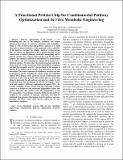| dc.contributor.author | Jung, Gyoo Yeol | |
| dc.contributor.author | Stephanopoulos, Gregory | |
| dc.date.accessioned | 2003-12-16T02:45:52Z | |
| dc.date.available | 2003-12-16T02:45:52Z | |
| dc.date.issued | 2004-01 | |
| dc.identifier.uri | http://hdl.handle.net/1721.1/3930 | |
| dc.description.abstract | Pathway optimization is, in general, a very demanding task due to the complex, nonlinear and largely unknown interactions of enzymes, regulators and metabolites. While in vitro reconstruction and pathway analysis is a viable alternative, a major limitation of this approach is the availability of the pathway enzymes for reliable pathway reconstruction. Here, we report the application of RNA display methods for the construction of fusion (chimeric) molecules, comprising mRNA and the protein they express, that can be used for the above purpose. The chimeric molecule is immobilized via hybridization of its mRNA end with homologous capture DNA spotted on a substrate surface. We show that the protein (enzyme) end of the fusion molecule retains its function under immobilized conditions and that the enzymatic activity is proportional to the amount of capture DNA spotted on the surface of a microarray or 96-well microplate. The relative amounts of all pathway enzymes can thus be changed at will by changing the amount of the corresponding capture DNA. Hence, entire pathways can be reconstructed and optimized in vitro from genomic information alone by generating chimeric molecules for all pathway enzymes in a single in vitro translation step and hybridizing on 96-well microplates where each well contains a different combination of capture DNA. We provide validation of this concept with the sequential reactions catalyzed by luciferase and nucleoside diphosphate kinase and further illustrate this method with the optimization of the five-step pathway for trehalose synthesis. Multi-enzyme pathways leading to the synthesis of specialty molecules can thus be optimized from genomic information about the pathway enzymes, provided the latter retain their activity under the in vitro immobilized conditions. | en |
| dc.description.sponsorship | Singapore-MIT Alliance (SMA) | en |
| dc.format.extent | 360813 bytes | |
| dc.format.mimetype | application/pdf | |
| dc.language.iso | en_US | |
| dc.relation.ispartofseries | Molecular Engineering of Biological and Chemical Systems (MEBCS); | |
| dc.subject | functional protein chip | en |
| dc.subject | in vitro metabolic engineering | en |
| dc.subject | combinatorial pathway optimization | en |
| dc.subject | trehalose synthesis | en |
| dc.title | A Functional Protein Chip for Combinatorial Pathway Optimization and In Vitro Metabolic Engineering | en |
| dc.type | Article | en |
